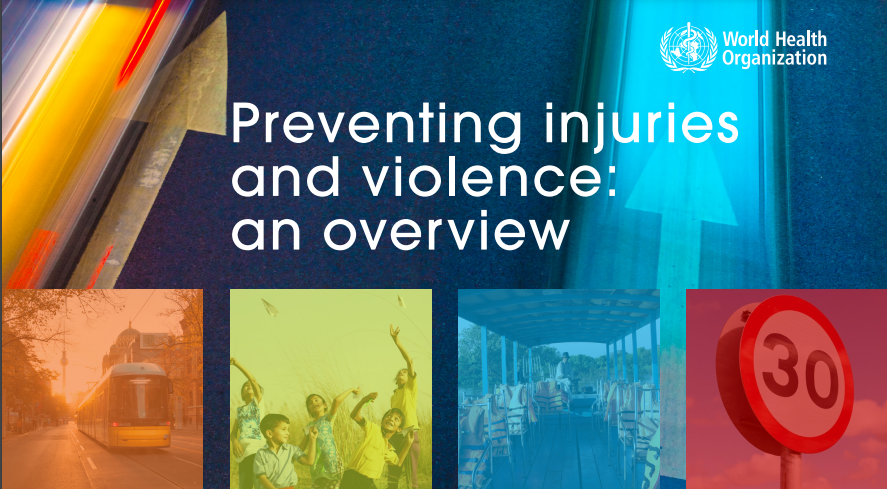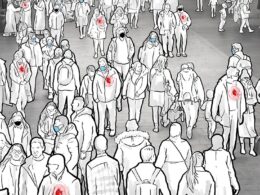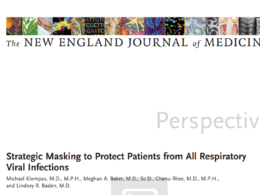health transformation institute (HTI)
research institute & knowledge portal
Joaquim Cardoso MSc*
Founder, Chief Researcher and Editor
November 28, 2022
MSc* from London Business School
MIT Sloan Masters Program
Key facts
What is the problem?
- Injuries — due to both unintentional causes and violence — took the lives of 4.4 million people around the world in 2019 and constitute 8% of all deaths[1].
- For people age 5–29 years, 3 of the top 5 causes of death are injury-related, namely road traffic injuries, homicide and suicide[2].
- Tens of millions of people suffer non-fatal injuries each year which lead to emergency department and acute care visits, hospitalizations, and treatment by general practitioners and can often result in temporary or permanent disability and the need for long-term physical and mental health care and rehabilitation.
- Injuries and violence are responsible for an estimated 8% of all years lived with disability[3].
- Injuries and violence place a massive burden on national economies, costing countries billions of US dollars each year in health care, lost productivity and law enforcement.
- Injuries and violence are not evenly distributed across or within countries — some people are more vulnerable than others depending on the conditions in which they are born, grow, work, live and age; in general, being young, male and of low socioeconomic status all increase the risk of injury.
What is the solution?
- There are numerous specific strategies based on sound scientific evidence that are effective and cost-effective at preventing injuries; it is critical that these strategies are more widely implemented.
- Providing high-quality support and care services to victims of injuries and violence can prevent fatalities, reduce the amount of short-term and long-term disability, and help those who are affected cope with the impacts of the injury or violence on their lives.
- While many sectors contribute to the prevention of injuries and violence, ministries of health have a particularly important role to play in preventing injuries and violence, treating victims, gathering data, and catalyzing action from other sectors, stakeholders and partners, including from industry.
- Preventing injuries and violence will facilitate achievement of several Sustainable Development Goal targets.
Injuries — due to both unintentional causes and violence — took the lives of 4.4 million people around the world in 2019 and constitute 8% of all deaths.
Injuries and violence place a massive burden on national economies, costing countries billions of US dollars each year in health care, lost productivity and law enforcement.
ORIGINAL PUBLICATION (full version)
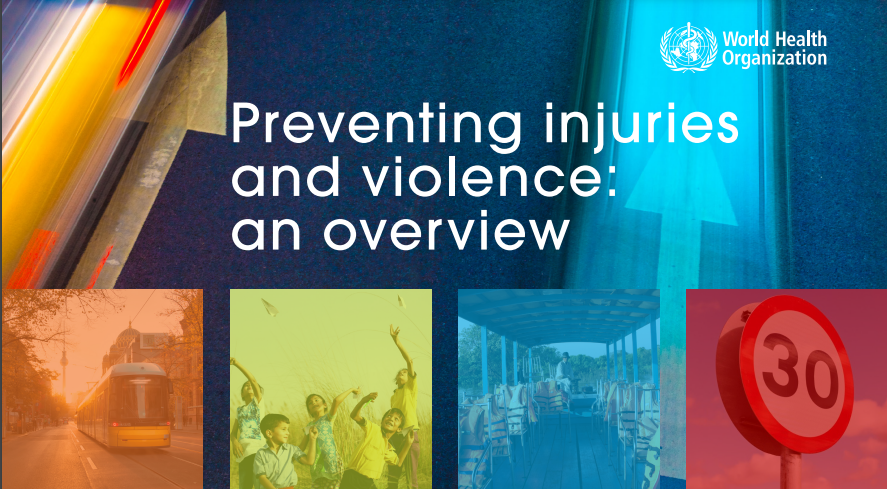
WHO
28 November 2022
Preventing injuries and violence: an overview
Overview
Injuries — due to both unintentional causes and violence — took the lives of 4.4 million people around the world in 2019 and constitute 8% of all deaths[4].
Of the 4.4 million injury-related deaths in 2019, unintentional injuries took the lives of 3.16 million people and violence-related injuries killed 1.25 million people.
Roughly 1 in 3 of these deaths resulted from road traffic crashes, 1 in 6 from suicide, 1 in 9 from homicide and 1 in 61 from war and conflict[5]. (See Figure 1.)
Figure 1. How injuries and violence claim lives
Source: Global Health Estimates, 2019
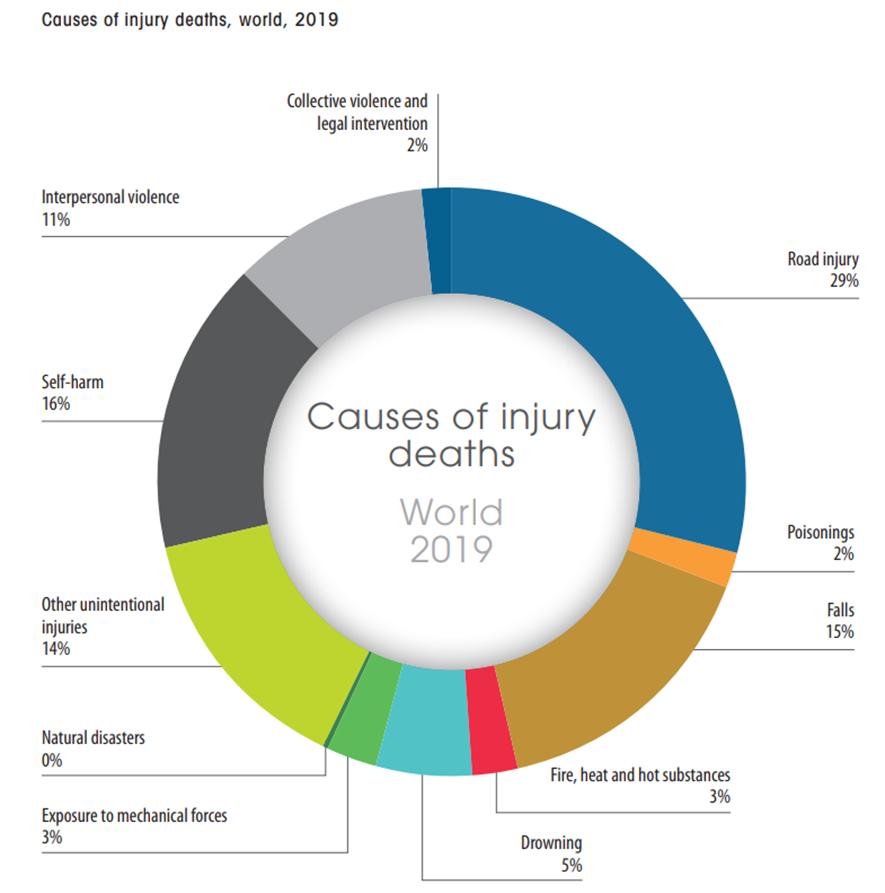
For people age 5–29 years, 3 of the top 5 causes of death are injury-related, namely road traffic injuries, homicide and suicide (see Table 1).
Road traffic injuries are the second leading cause of death and drowning is the sixth leading cause of death for children age 5–14 years[6].
Falls accounted for over 684 000 deaths in 2019 and are a growing and under-recognized public health issue[7].
Tens of millions more people suffer non-fatal injuries each year which lead to emergency department and acute care visits, hospitalizations or treatment by general practitioners and often result in temporary or permanent disability and the need for long-term physical and mental health care and rehabilitation.
For example, there has been a significant rise in road traffic injuries in the African region since 2000, with a 75% increase of healthy life-years lost to disability[8].
Table 1. Injuries and violence leading killers of youth
Leading causes of death by age group, both sexes, world, 2019
Source: Global Health Estimates, 2019
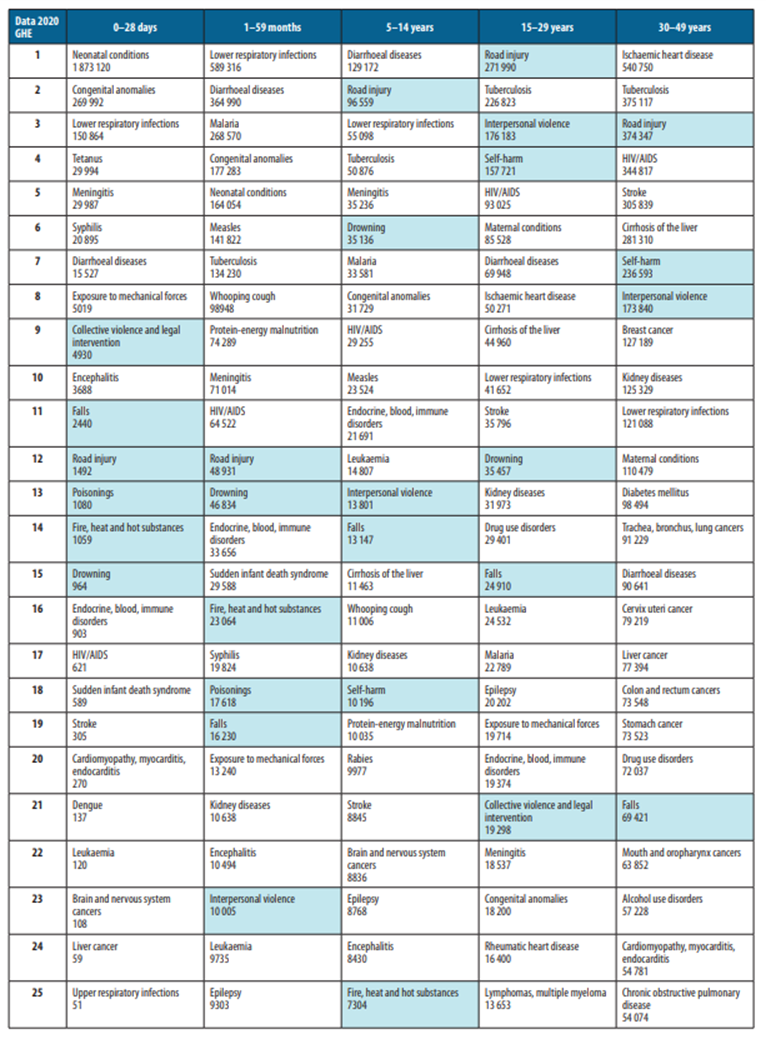
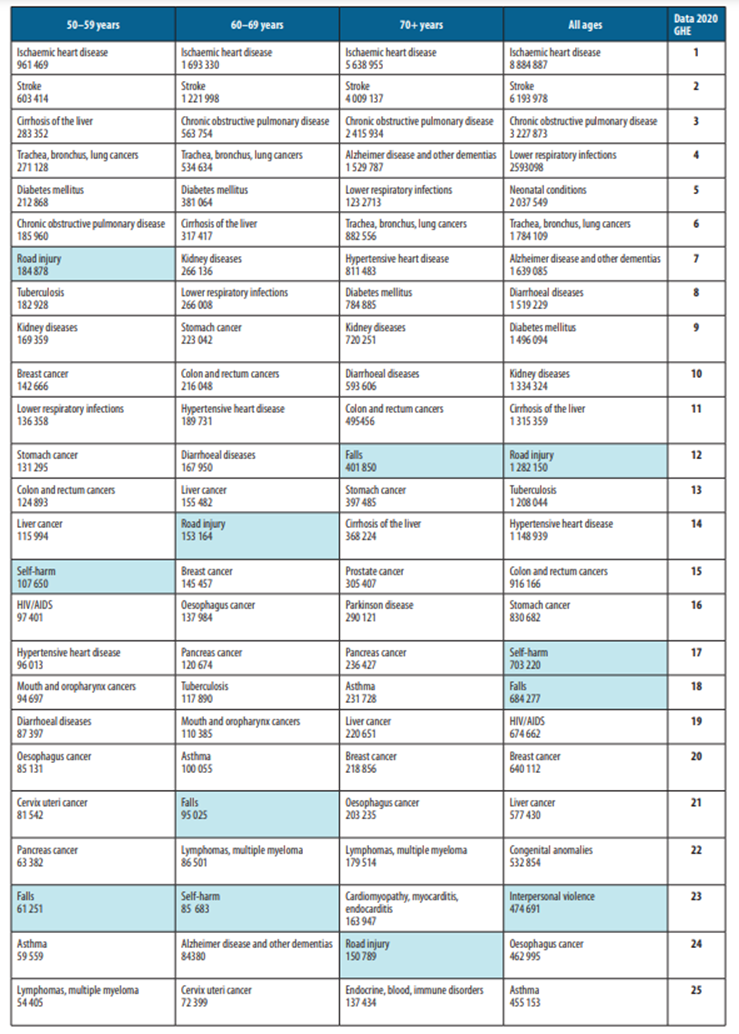
Impact
Beyond death and injury, exposure to any form of trauma, particularly in childhood, can increase the risk of mental illness and suicide; smoking, alcohol and substance abuse; chronic diseases like heart disease, diabetes and cancer; and social problems such as poverty, crime and violence.
For these reasons, preventing injuries and violence, including by breaking intergenerational cycles of violence, goes beyond avoiding the physical injury to contributing to substantial health, social and economic gains.
Injuries and violence are a significant cause of death and burden of disease in all countries; however, they are not evenly distributed across or within countries — some people are more vulnerable than others depending on the conditions in which they are born, grow, work, live and age.
For instance, in general, being young, male and of low socioeconomic status all increase the risk of injury and of being a victim or perpetrator of serious physical violence.
The risk of fall-related injuries increases with age.
Twice as many males than females are killed each year as a result of injuries and violence[9].
Worldwide, about three quarters of deaths from road traffic injuries, four fifths of deaths from homicide, and almost two thirds of deaths from war (direct deaths from conflicts and executions) are among men[10].
In many low- and middle-income countries, however, women and girls are more likely to be burned than men and boys, in large part due to exposure to unsafe cooking arrangements and energy poverty.
Across all ages, the three leading causes of death from injuries for males are road traffic injuries, suicide and homicide, while for females they are road traffic injuries, falls and suicide[11].
Twice as many males than females are killed each year as a result of injuries and violence
Poverty also increases the risk of injury and violence. Almost 90% of injury-related deaths occur in low- and middle-income countries[12].
Across the world, injury death rates are higher in low-income countries than in high-income countries.
Even within countries, people from poorer economic backgrounds have higher rates of fatal and non-fatal injuries than people from wealthier economic backgrounds.
This holds true even in high-income countries.
The uneven distribution of injuries that makes them more prevalent among the less advantaged is related to several risk factors.
These include living, working, travelling and going to school in more precarious conditions, less focus on prevention efforts in underprivileged communities, and poorer access to quality emergency trauma care and rehabilitation services.
These issues are explained in more detail below.

Risk factors and determinants
Risk factors and determinants common to all types of injuries include
- alcohol or substance use;
- inadequate adult supervision of children;
- and broad societal determinants of health such as poverty;
- economic and gender inequality;
- unemployment;
- a lack of safety in the built environment, including unsafe housing, schools, roads and workplaces; inadequate product safety standards and regulations;
- easy access to alcohol, drugs, firearms, knives and pesticides;
- weak social safety nets;
- frail criminal justice systems;
- and inadequate institutional policies to address injuries in a consistent and effective manner, in part due to the availability of sufficient resources.
In settings where emergency trauma care services are weak or there is inequitable access to services, the consequences of injuries and violence can be exacerbated.
In addition to the above, risk factors and determinants for specific injury-related causes include:
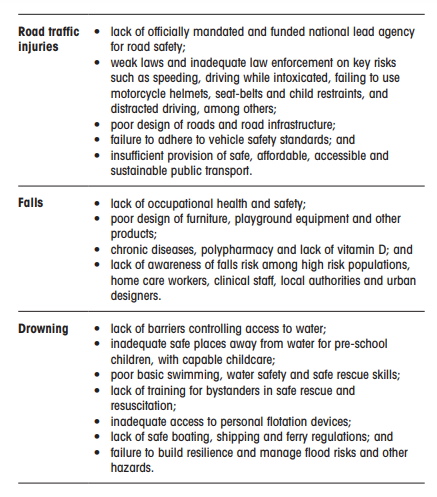
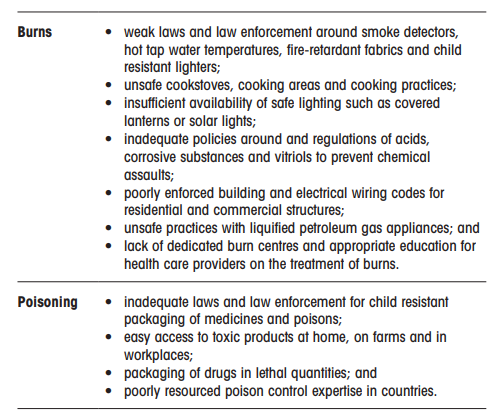
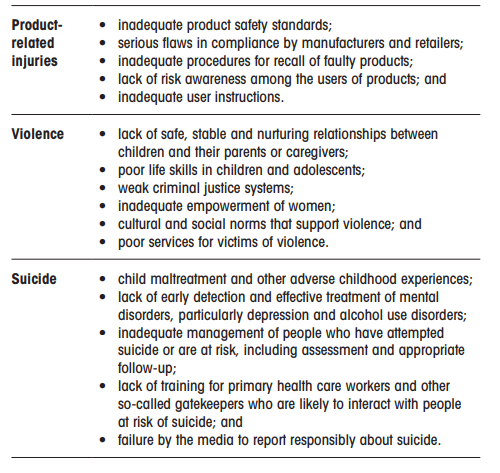
Prevention
Injuries and violence are predictable and there is compelling scientific evidence for what works to prevent injuries and violence and to treat their consequences in various settings.
This evidence has been collated into technical documents that can serve as a guide to support decisions for scaling up injury and violence prevention efforts — see:
· Save LIVES: a road safety technical package
· Preventing drowning: an implementation guide
· Step safely: strategies for preventing and managing falls across the life-course
· Violence prevention: the evidence
· INSPIRE: seven strategies for preventing violence against children
· RESPECT women: preventing violence against women
· LIVE LIFE: suicide prevention implementation package
· SAFER: a world free from alcohol related harms
Preventing injuries and violence will facilitate achievement of several Sustainable Development Goal targets.
Analysis of the costs and benefits for several selected injury and violence prevention measures shows that they offer significant value for money, making investment in such measures of great societal benefit.
For example, with regard to child injury prevention, a study found that every US$ 1 invested in smoke detectors saves US$ 65, in child restraints and bicycle helmets saves US$ 29, and in-home visitation saves US$ 6 in medical costs, loss productivity and property loss[13] [14].
…(1) every US$ 1 invested in smoke detectors saves US$ 65, (2) in child restraints and bicycle helmets saves US$ 29, and (3) in-home visitation saves US$ 6 in medical costs, loss productivity and property loss
In Bangladesh, teaching school-age children swimming and rescue skills returned US$ 3000 per death averted[15].
The social benefits of injuries prevented through home modification to prevent falls have been estimated to be at least six times the cost of intervention[16].
It is estimated that in Europe and North America, a 10% reduction in adverse childhood experiences could equate to annual savings of 3 million Disability Adjusted Life Years or US$ 105 billion[17].
Although progress has been made in some countries in preventing injuries and violence, all countries should increase their investments in prevention.
In addition to enhancing emergency trauma care and services and ensuring robust data collection systems, other proven prevention measures by cause of injury include:
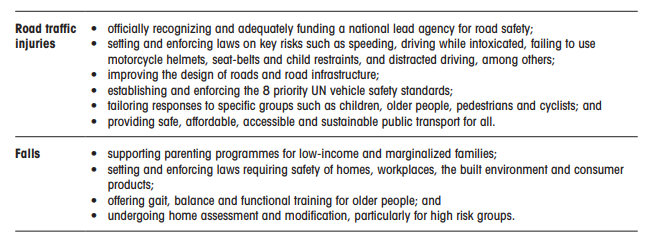
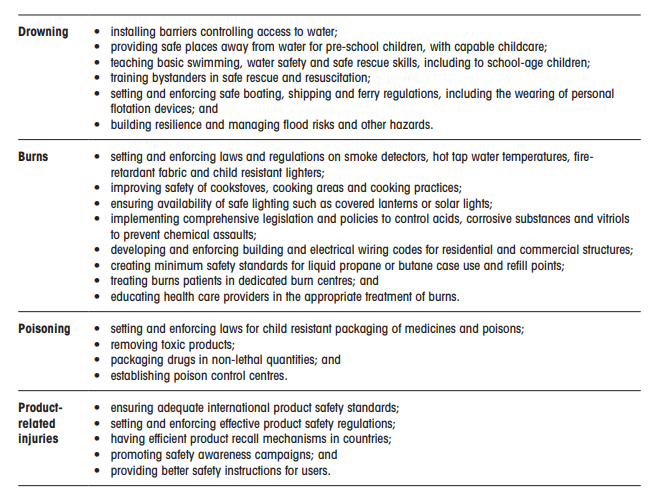
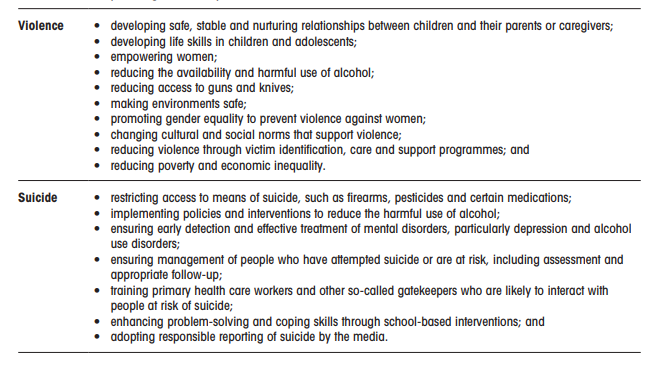
Post-injury care
For all injuries and violence, providing quality emergency care for victims can prevent fatalities, reduce the amount of short-term and long-term disability, and help those affected to cope physically, emotionally, financially and legally with the impact of the injury or violence on their lives.
As such, improving the organization, planning and access to trauma care systems, including telecommunications, transport to hospital, prehospital and hospital-based care, are important strategies to minimize fatalities and disabilities from injury and violence.
Providing rehabilitation for people with disabilities, ensuring they have access to assistive products such as wheelchairs, and removing barriers to social and economic participation are key strategies to ensure that people who experience disability as the result of an injury or violence may continue a full and enjoyable life.

WHO response
WHO supports efforts to address injuries and violence in many ways, including by:
- developing and disseminating guidance for countries on evidence-based policy and practice, through such resources as Save LIVES: a road safety technical package;
- Preventing drowning: an implementation guide; Step safely: Strategies for preventing and managing falls across the life-course;
- Violence prevention: the evidence;
- INSPIRE: Seven strategies for preventing violence against children, RESPECT women: Preventing violence against women,
LIVE LIFE: suicide prevention implementation package and
SAFER: a world free from alcohol related harms; - providing technical support to countries through programmes such as the Bloomberg Initiative for Global Road Safety and the Global Partnership to End Violence against Children;
- documenting and disseminating successful injury prevention approaches, policies and programmes across countries
- monitoring progress towards achieving the Sustainable Development Goal targets linked to injury, violence prevention, mental health and substance use — namely targets 3.4, 3.5, 3.6, 5.2, 5.3, 16.1 and 16.2 — through global status reports on road safety and violence prevention, and on alcohol and health, and world reports on preventing suicide, including most recently the Global status report on road safety 2018 and the Global status report on preventing violence against children 2020;
- through informal networks chaired by WHO such as the UN Road Safety Collaboration and the Violence Prevention Alliance, and others towards which WHO contributes like the Global Partnership to End Violence against Children, coordinating global efforts across the UN system including decades of action, ministerial conferences and weeks and days dedicated to injury-related topics to improve road safety and end violence;
- clarifying the role of Ministries of Health as part of multi-sectoral injury-prevention efforts, as reflected in Preventing injuries and violence: a guide for ministries of health, including its role in collecting data; developing national policies and plans; building capacities; facilitating prevention measures;
providing services for victims, including emergency trauma care; promulgating legislation on key risks;
and training journalists to improve reporting on these issues with a focus on solutions and by co-hosting biannual global meetings and regional meetings of Ministry of Health focal points for violence and injury prevention; and - co-hosting and serving on the International Organizing Committee for the series of biannual World Conferences on Injury Prevention and Safety Promotion, the 14th edition of which will take place in Adelaide, Australia in 2022.
References
1. Global health estimates [online database]. Geneva: World Health Organization; 2019 (Mortality and global health estimates (who.int), accessed 7 April 2022).
2. Bishai D, Hyder A. Modeling the cost effectiveness of injury interventions in lower and middle income countries: opportunities and challenges. Cost Effectiveness and Resource Allocation 4, no. 1 (2006): 1–11.
3. Karoly L, Kilburn M, Cannon J. Early childhood interventions: proven results, future promise. Santa Monica, CA: RAND Corporation; 2005, (Early Childhood Interventions: Proven Results, Future Promise | RAND), accessed 7 April 2022.
4. METRC 2022. Patient-specific precision injury signatures to optimize orthopaedic interventions in multiply injured patients (PRECISE STUDY). Journal of orthopaedic trauma, vol. 36, pp. S14-S20.
5. Keall MD, Pierse N, Howden-Chapman P, Guria J, Cunningham CW, Baker MG. Cost-benefit analysis of fall injuries prevented by a programme of home modifications: a cluster randomised controlled trial.” Inj Prev. 2017;23(1):22–6.
6. Bellis M, Hughes K, Ford K, Rodriguez G, Sethi D, Passmore J. Life course health consequences and associated annual costs of adverse childhood experiences across Europe and North America: a systematic review and meta-analysis. Lancet Public Health. 2019 Oct;4(10):e517-e528.
Originally published at https://www.who.int




